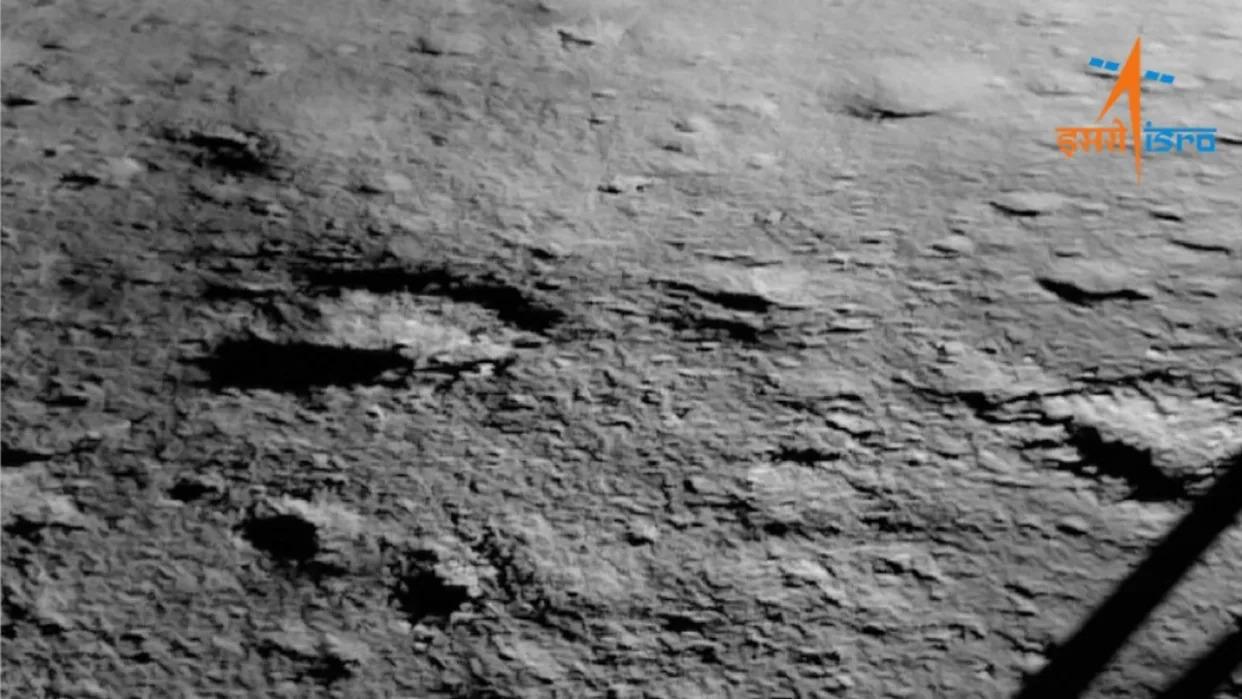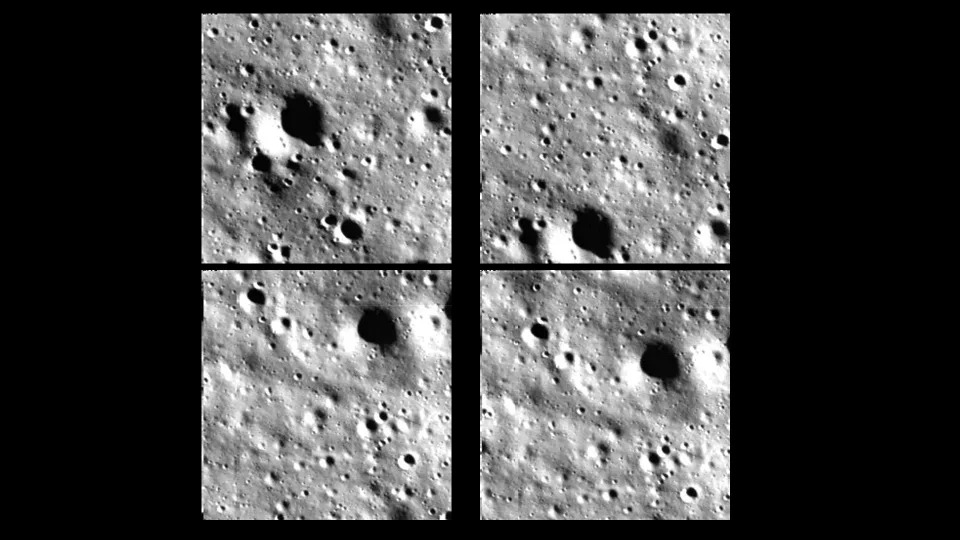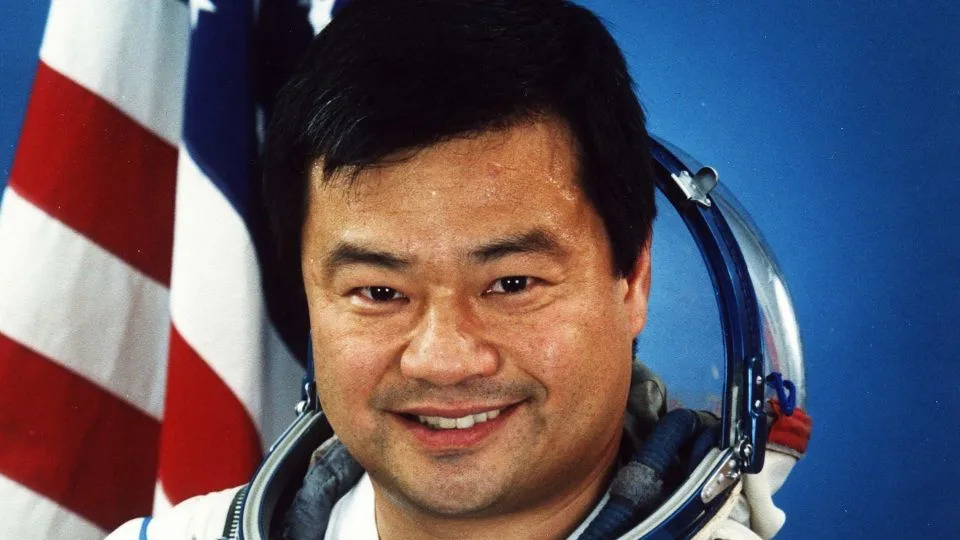Tereza Pultarova
Wed, August 23, 2023

the gray surface of the moon can be seen beside the leg of a lunar lander
The first images from India's Chandrayaan-3 mission taken after the probe's historic moon touchdown reveal a pockmarked surface near the lunar south pole.
The Indian Space Research Organisation (ISRO) shared the images on X, formerly Twitter, on Wednesday (Aug. 23), about four hours after the Chandrayaan-3 spacecraft completed its smooth descent.
The first set of four images were taken by the lander's Horizontal Velocity Camera as it was nearing the surface of the moon. An additional image from the Landing Imager Camera, shared a little later, shows a glimpse of the landing site, including a portion of the spacecraft's landing leg and its shadow.
"The communication link is established between the Ch-3 Lander and MOX-ISTRAC, Bengaluru," ISRO said in a post on X. "Chandrayaan-3 chose a relatively flat region on the lunar surface," the agency added in the subsequent post.
Related: India on the moon! Chandrayaan-3 becomes 1st probe to land near lunar south pole
The landing made India only the fourth country in history to successfully put a spacecraft on the surface of the moon, after the United States, the former Soviet Union and China. Chandrayaan-3 is also the first spacecraft in history to touch down near the lunar south pole, an area that is currently attracting the attention of scientists and space agencies from all over the world.
Scientists think that the permanently shadowed polar craters contain water ice trapped in the rocks, which could be extracted and used to support a permanent human presence on Earth's natural companion. Moreover, these lunar craters could be used to build next-generation telescopes that would allow astronomers to see farther than they can today.

A sequence of images of the moon's surface taken by India's Chandrayaan-3 spacecraft during its descent to the lunar south pole.
A small rover called Pragyan arrived on board Chandrayaan-3 and will soon deploy and commence its exploration of the exciting region, so many more fascinating images are likely to come soon. Both the rover and the lander, however, are unlikely to remain operational for more than two weeks, as ISRO doesn't expect the vehicles' batteries to make it through the two-week lunar night.
Chandrayaan-3 was India's second try at landing near the moon's south pole. The country's first attempt at a lunar touchdown, in September 2019, failed when the Chandrayaan-2 lander crashed into the moon due to a software glitch.
India's triumph comes only three days after Russia lost its Luna-25 mission, its first attempt to put a spacecraft on the moon's surface in 47 years. Luna-25, too, was aiming for the lunar south pole, but crashed into the moon instead after a botched orbital maneuver on Saturday (Aug. 19).
Opinion by Leroy Chiao
Wed, August 23, 2023
Editor’s Note: Leroy Chiao, PhD, works as a consultant, and is the CEO and co-founder of One Orbit LLC, a motivational training, education and talent management company. He served as a NASA astronaut from 1990-2005 and flew four missions into space aboard three Space Shuttles – and once as the copilot of a Russian Soyuz spacecraft to the International Space Station, where he served as the commander during Expedition 10. The views expressed in this commentary are his own. Read more opinion at CNN.
There are many reasons why nations create and continue civil space programs. Some hope to advance their civilian efforts in science and technology, others seek to expand their technical workforce, and still others are seeking a way to motivate the next generation of young workers
.
Leroy Chiao - CNN
Since the dawn of the space race however, the biggest motivation by far has been enhancing the sense of national prestige, at home and internationally.
That’s a big part of what’s driving India, which on Wednesday became only the fourth nation to successfully soft-land a probe on the Moon.
The milestone marks a huge accomplishment for its nascent space program, which has made steady progress over the years. I expect future success to follow: Delhi has shown it is committed to making significant investments in space exploration efforts.
At the dawn of the space age, the Soviet Union, which understood only too well how a successful space program could bolster its standing on the national stage, struck first with the launch of Sputnik, the first satellite in 1957.
Although it transmitted only a simple beeping signal, the implications of the launch were huge; the Soviet Union could now strike its enemies, including the United States, with nuclear missiles. Moscow followed that breakthrough with others, including the first animal in orbit (the dog Laika in 1957) and the first human in space (Yuri Gagarin in 1961).
As Russia notched success after success in space, America was in a near panic. Although the US followed with our own successes, the early impression was that we trailed the Soviets technologically. That’s why President John F. Kennedy’s call to land American astronauts on the Moon resonated so profoundly for our nation, garnering enthusiastic support from both Democrats and Republicans in Congress, as well as with the American public more broadly.
The race to space was seen as being almost as a war of survival, one which we could not afford to lose.
Russian President Vladimir Putin is the latest in a long line of leaders to attempt to use a successful space venture to reflect his nation’s greatness. Putin had hoped this week to bask in the glow of a successful landing of the Russian Luna-25 moon lander.
For extra effect, the Russian president — badly in need of a national prestige win — timed the lunar mission to take place just days ahead of a voyage to the Moon by the rival Indian vehicle, the Chandrayaan-3 spacecraft.
Russia won the race but lost the game: A malfunction caused Luna-25 to crash instead of soft-land on the lunar surface. Had it been successful, Luna-25 doubtless would have been touted as “proof” that Russia was still a great nation, despite its setbacks in its disastrous war in Ukraine. (This type of mission is especially difficult because the orbit change maneauvers to land at one of the poles have to be done precisely).
If these space programs are mirrors of greatness for nations, then it is interesting to more closely examine them. On the rise are the programs of Asia, most notably China and India. Both countries have developed sophisticated cryogenic rocket engines, launchers and spacecraft. Both operate several constellations of satellites for communication, Earth imaging and remote sensing, and China has its own navigation satellite constellation.
China also boasts a human spaceflight program with an operational space station, including crew and cargo transport spacecraft. India has plans to send its own astronauts into orbit in the next few years, while China has announced plans to send its astronauts to the lunar surface in the 2030s.
China’s lunar rover is still actively exploring the far side of the Moon, the only country so far to have placed a lander there.

Students hold posters as they gather in support of the Chandrayaan-3 spacecraft in Mumbai on August 22, 2023. - Indranil Mukherjee/AFP/Getty Images
In the International Space Station (ISS) partnership, the US, Europe, Japan and Canada also continue to move forward with space exploration. After years of delay and cost overruns, the Artemis I mission was finally launched last year and NASA has named the Artemis II crew which includes a Canadian astronaut. NASA plans to return humans to the Moon in the coming years, something that hasn’t happened since the last Apollo landing in 1972.
These countries also continue to launch satellites and other spacecraft. NASA continues, meanwhile, to operate rovers on Mars. And one of the most exciting developments in the West are the partnerships between commercial space companies and NASA.
SpaceX has been a NASA partner for many years, sending supplies and crew to the ISS. They are also developing a lunar lander for NASA, as is a team led by billionaire Jeff Bezos’ Blue Origin. Several smaller companies are participating in contracts to provide spacecraft and services for lunar exploration, in what is proving to be a relentless forward push into space on multiple fronts.
Russia is the one exception. Instead of expanding, its space program has been in decline for several years. The once-great program began disintegrating after the fall of the Soviet Union and the downward spiral now appears to be accelerating. Cosmonaut Sergei Krikalev was stranded on the Mir space station for nearly a year because of the collapse of the Soviet Union and immediate chaos that followed.
Their program was arguably saved by the US, which supported the Mir space station and brought Russia into what became the ISS program, with cash for services and contracts to produce the core modules and other equipment.
Make no mistake, Russia has also been a key partner in the ISS program. They have provided crew and cargo transportation (including for my crew during Expedition-10), while the Space Shuttle was grounded after the Columbia accident.
Until recently, Russian rockets and spacecraft were among the most safe and reliable. But now the future of Russia’s space program is in doubt, amid continuing funding cuts, allegations of corruption (for example, the scandals related to the building of the Vostochny launch complex), politicization (for instance the reign of former Roscosmos director, career-politician Dmitry Rogozin), and the lack of young professionals in their pipeline (the low-paying jobs are not attractive to prospective workers.)
In recent years, Russia has seen failures of Soyuz and Progress spacecraft and launchers, including the 2018 launch abort of Soyuz MS-10 which had US astronaut Nick Hague onboard. Luna-25 is just the latest in a string of failures. Thankfully, none of these has yet resulted in any deaths or injuries.
Russia’s bedraggled space program mirrors the state of the nation itself, including the surprisingly poor performance of the Russian military in its war on Ukraine. Instead of making his nation a “great power” again, Putin has shown the world just how badly Russia is in decline.
The lamentable state of Moscow’s space program is just the latest confirmation of that.
Watch the historic moment India successfully lands on the south pole of the moon, beating the US, China, and Russia
Morgan McFall-Johnsen,Marianne Guenot
Wed, August 23, 2023

Indian spacecraft Chandrayaan-3, the word for "moon craft" in Sanskrit, travels after it was launched from the Satish Dhawan Space Centre in Sriharikota, India.Aijaz Rahi/AP Photo
In a historic first, India's Chandrayaan-3 spacecraft has landed on the moon's south pole.
India's first attempt failed and Russia has also crashed a lander on the water-rich south pole.
"India is now on the moon," said Indian prime Minister Narendra Modi as engineers celebrated on Wednesday.
India on Wednesday achieved a historic feat in the history of space exploration: landing a robot on the moon's south pole.
"India is now on the moon," said Indian prime Minister Narendra Modi from South Africa, as engineers celebrated the nation's Chandrayaan-3 spacecraft landing on the south pole of the moon.
With the landing, India became the first country to touch down on what is thought to be the most water-rich region on the moon — a feat that has stumped Russia, which crashed its lander on the moon Saturday.
Watch the livestream of the mission in its final moments, with mission control erupting in applause and Prime Minister Narendra Modi cracking a smile as the lander touches down:
And a CGI rendering of what the landing could have looked like:

A still from a livestream shows a 3D reconstitution of India's historic moon landing on August 23. India became the first nation to land a robotic mission to the crucial south pole of the Moon.ISRO
The landing means India beat Russia, China and the US, who have all announced missions to the south pole.
Whoever can mine that water-ice and break it down into oxygen and hydrogen, will then have the resources to lead future space exploration including building crewed bases on the moon and manufacturing rocket fuel for missions to Mars and beyond.
This is "a pretty significant achievement," Robert Braun, head of the Space Exploration Center at Johns Hopkins Applied Physics Laboratory, told Insider.
India and Russia tried and failed
Russia was the latest nation to fumble a lunar south-pole landing.
During a maneuver to push itself into an orbit that would carry it to its descent, the Luna-25 spacecraft fired its engines for too long, Roscosmos reported.
The agency lost contact with the spacecraft on Saturday and determined that it crashed into the moon.
Luna-25 joins the wreckage of India's failed first attempt.
If first you don't succeed try, try, again
The landing attempt was India's second try.

Members of India's Bharatiya Janata Party perform Hindu rituals for the success of Indian spacecraft Chandrayaan-3 inside a temple in Mumbai.Rajanish Kakade/AP Photo
Its space agency sent its first craft to the moon's south pole in September 2019. The Chandrayaan-2 mission dropped a lander called Vikram toward the lunar surface.
On its descent, just 1.3 miles above the moon's surface, the Vikram lander diverged from its intended path and lost communication with operators on Earth.
Later, NASA's lunar orbiter spotted the wreckage of Vikram on the moon below. India took another swing with Chandrayaan-3, and it worked.
As with any descent and landing operation, hundreds of pre-programmed actions had to go perfectly, in the correct sequence, for the spacecraft to make it to the surface intact and functioning.

Indian Space Research Organization (ISRO) Chairman Kailasavadivoo Sivan displays a model of Chandrayaan 2 orbiter and rover during a press conference at their headquarters in Bangalore, India.Aijaz Rahi/AP Photo
"Spaceflight is hard, and landing on another planetary surface is among the hardest things that we do in spaceflight. So it's the hardest of the hard," said Braun, who has worked on landing and descent teams for multiple NASA missions to Mars.
Correction August 23, 2023: An earlier version of this article misstated how many countries tried to land on the lunar south pole. Two countries have attempted this feat so far: India and Russia. Only India has succeeded. This post has also been updated to reflect the outcome of the Chandrayaan-3 moon landing. It was originally published on August 22, 2023.

No comments:
Post a Comment